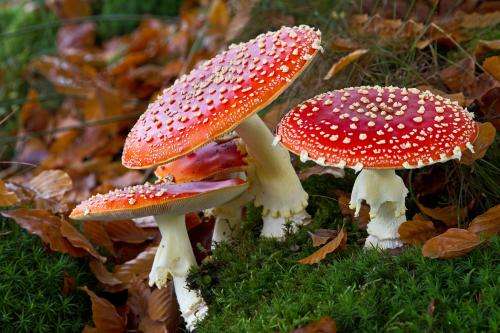Getting a jump on plant-fungal interactions

Fungal plant pathogens may need more flexible genomes in order to fully benefit from associating with their hosts. Transposable elements are commonly found with genes involved in symbioses.
Transposable elements (TEs) are DNA sequences that can "jump" around the genome that were originally dismissed as junk DNA. As more genome sequences have become accessible, researchers are finding that transposable elements play roles in genomic variation. Fungal researchers have found a correlation between symbiotic plant pathogens and the amount of transposable elements. To learn more about this association and whether or not it is useful in plant-fungal symbioses, a team including U.S. Department of Energy Joint Genome Institute (DOE JGI) researchers applied short-read sequencing and compared the genomes of related asymbiotic and ectomycorrhizal fungi within the genus Amanita. The work was published ahead online June 12, 2014 in Genome Biology and Evolution.
Working with collaborators at Harvard University, the DOE JGI has already sequenced and assembled the genome of Amanita thiersii, a fungus commonly found on lawns that decomposes leaf litter, as part of a project under the DOE JGI's Community Science Program. For this project, the genome of A. thiersii and of A. muscaria, another fungus sequenced and assembled at the DOE JGI, were compared against other fungal genomes that came from samples collected around the world.
The team compiled an aggregate TE library from all those found in the fungal genomes used in the analysis. Among their findings was that there are significantly more TEs in the genomes of ectomycorrhizal fungi compared to asymbiotic fungi. A. thiersii's genome had more TEs relative to the amount of coding sequence than any of the other fungal genomes in the analysis. Additionally, in the ectomycorrhizal fungi, some TEs were "younger" and had been inserted later.
"TE survival depends on the impact an insertion has on the genome," the researchers wrote, "and, if it is delirious, the ability of natural selection to remove it from te population before it is fixed…. Understanding patterns of TE distribution across a phylogeny and differentiating among the processes that drive patterns requires rich, contextual information about species' natural histories."
More information: Hess J et al. "Transposable element dynamics among asymbiotic and ectomycorrhizal Amanita fungi." Genome Biol Evol. 2014 Jun 12. pii: evu121. [Epub ahead of print]. DOI: 10.1093/gbe/evu121
Journal information: Genome Biology , Evolution
Provided by US Department of Energy





















